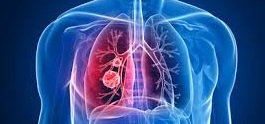
Lung cancer is a malignant neoplasm of the lung that originates from the epithelial tissue of the bronchi of various calibers. Lung cancer was a rare disease at the beginning of the 20th century, but the growing exposure to tobacco smoke and other causative agents of this disease has led to an increase in the number of this pathology. Today, lung cancer is the leading cause of cancer deaths worldwide, in both men and women. Survival rates vary depending on the type of cancer cells and at what stage the disease was diagnosed. In the structure of oncological pathologies in the Republic of Kazakhstan, lung cancer ranks 2nd and 1st in terms of mortality.
Risk factors for developing lung cancer:
Smoking cigarettes, pipes or cigars now or in the past. It is the most important risk factor for developing lung cancer. The earlier in life a person starts smoking, the greater the risk of developing lung cancer. The occurrence of lung cancer is associated with the action of carcinogens contained in tobacco smoke. Stopping smoking is the most effective way to reduce the chance of getting sick, regardless of age.
People who do not smoke on their own, but who inhale tobacco smoke (passive smoking) are also at risk of developing the disease. If there is one smoker in a married couple, then for the second the probability of developing lung cancer increases by 30% compared to a couple where both do not smoke. The negative effect of tobacco smoke can exacerbate the lack of vegetables and fruits in the diet.
Lung cancer affects people working in mines and industry who come into contact with radon and asbestos in their work. These substances enter the lungs and damage its cells, increasing the risk of malignant pathology by several times.
Other risk factors for lung cancer include:
radiation therapy to the breast or chest cavity;
radon in the home or workplace;
imaging testing such as computed tomography;
air pollution;
burdened history;
carriers of the human immunodeficiency virus (HIV);
taking beta-carotene supplements and being a heavy smoker;
older age is a major risk factor for most types of cancer;
contact with asbestos, radon, arsenic, nickel, cadmium, chromium, chloromethyl ether.
Symptoms:
Sometimes lung cancer causes no signs or symptoms. It may be detected during a chest x-ray taken to examine another condition. In addition, the signs and symptoms of lung cancer can also be caused by other diseases.
The most common symptoms and signs of lung cancer are:
a cough that becomes permanent and may be bloody;
loss of appetite;
weight loss;
respiratory failure;
chest pain, shortness of breath;
bone pain
swelling of the face and neck;
hoarseness of voice;
thickening or swelling of the fingers and toes;
feeling tired.
Progression of lung cancer (metastases) can cause:
bone pain;
weakness in the limbs;
neurological symptoms (eg, dizziness);
the appearance of yellowness on the face and in the eyes.
Diagnosis of lung cancer:
Diagnosis of lung cancer, in addition to standard examinations, including blood tests and an assessment of the general condition of the patient, consists of the following procedures:
R - graphy of the chest;
CT or MRI;
endoscopic diagnostic method - bronchoscopy, during which a biopsy can be performed;
surgical diagnostic method, including transthoracic biopsy under ultrasound or CT control;
PET - CT.
Considering recent advances in the treatment of oncological diseases, pathomorphological diagnostics is extremely important, including histological, immunohistochemical and molecular genetic studies to determine the morphological subtype.
Recommendations of an oncologist for lung cancer:
Prevention of lung cancer includes the following recommendations:
giving up bad habits, especially smoking;
adherence to a healthy lifestyle: proper nutrition rich in vitamins and daily physical activity, walks in the fresh air.
timely treatment of bronchial diseases in order to prevent the transition to a chronic form.
daily wet cleaning of the apartment and ventilation of the premises;
reducing contact with harmful chemicals and heavy metals to a minimum. During work, be sure to use protective equipment: respirators, masks.
in the event of the symptoms that are described in this article, it is imperative to see a doctor for an accurate diagnosis.
NROC can offer the full range of diagnostic studies and treatment of lung cancer.




